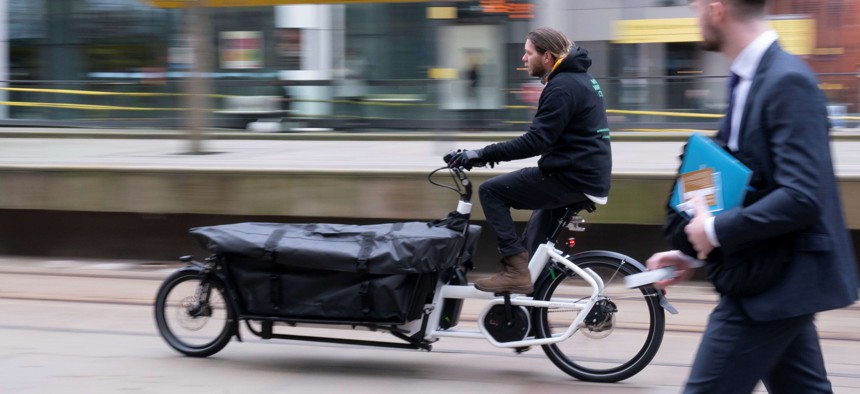Safety Group Offers Warnings on Emerging Transportation Tech

A staff member rides an electric bike during an eCargo bike launch in Manchester, Britain, on Jan. 17, 2022. A U.S. safety group is telling cities they should prepare for new types of vehicles on their streets, possibly including bulkier bikes like these. Photo by Jon Super/Xinhua via Getty Images
They’re urging state and local government leaders to prepare for new types of vehicles and to look beyond industry hype as they design policies to reduce crashes.
Cities should prepare for new kinds of vehicles that could use their streets and sidewalks, including delivery robots and electric vehicles that blur the lines between bicycles, cars and motorcycles, according to a prominent road safety group.
The National Safety Council this week urged state and local officials to change their approach to regulating city streets, in order to prepare for the advent of new technologies like these and to reverse a recent surge in traffic deaths.
The council, in a new report, also predicted that fully autonomous vehicles will not be widely deployed in the next 20 years, but said that related technologies could help decrease traffic crashes. For instance, Advanced Driver Assistance Systems, which can help detect pedestrians or automatically brake a vehicle to avoid a crash, could improve safety, the report said.
Mark Chung, the executive vice president of roadway practice at the National Safety Council, said the group is hoping to prevent local officials from being blindsided by rapid changes in technology, as they have been over the last two decades with innovations such as ride-booking apps, electric scooters and bike sharing.
“Public officials, and many advocacy groups, were caught off guard by this unprecedented rate of technological change, and they were often unsure how to respond to the safety concerns that emerged,” Chung said. “Preparing in advance for the next generation of transformative technology and taking time to reflect on our current environment can save lives.”
David Zipper, the author of the report and a visiting fellow at the Harvard Kennedy School, said the technologies people used to get around cities in 1920 were essentially the same as they were in 2000. People could walk, bike, drive, or take transit. But much of that changed in the last 20 years, and those advances will likely continue, especially with the development of autonomous vehicles and related technology, he said.
“The next 20 years are going to be just as disruptive,” Zipper said at an event Wednesday. “Those technologies complicate the challenges around safety. They create opportunities, but they also create risks.”
Zipper also pointed out that the problem of increased traffic deaths is unique to the United States. Road fatalities have decreased in most developed countries, including Canada, he noted.
Kristina Swallow, the director of the Nevada Department of Transportation, said transportation agencies need to take a broader look at factors contributing to road deaths in order to make streets safer. Swallow will help the National Safety Council explore those questions as a member of its new Mobility Safety Advisory Group.
“To achieve the goal of zero fatalities, we must be willing to ask challenging questions,” she said. “For instance, are the decisions being made in roadway design, city planning and land use contributing to the solution? If not, how can we work together across industries and all levels of government to more effectively achieve our common goal?”
Prioritizing ‘Mundane’ Safety Policies
The safety council warned local officials not to reconfigure their streets and laws to accommodate the auto industry’s wishes to ease the transition to autonomous vehicles. Cities did that a century ago by introducing jaywalking ordinances and other changes to prioritize cars over non-motorized traffic, it noted. The group said efforts to simplify streetscapes for robotic vehicles “should be resisted.”
“Although exciting new mobility technologies attract media attention and investment dollars, many of the most compelling opportunities to improve urban street safety lie in mundane policy approaches like extending sidewalks, building protected bike lanes and imposing road diets. To reduce road deaths, we need better policies and street designs as well as innovative technology products like ADAS [Advanced Driver Assistance Systems],” the group wrote.
The safety council said innovations in transportation technology, like trikes and sidewalk robots, were more likely to be rolled out in dense neighborhoods. People in those areas make shorter trips and can use better networks of sidewalks and bike lanes.
“Parcel delivery, in particular, becomes more feasible on an e-cargo bike or drone in a dense neighborhood. Congestion at the curb could become a growing problem in such areas,” the group cautioned in the report.
“Especially if cities move to charge companies for curb access (or ban delivery vans outright, as has happened in Europe), technologies like cargo bikes, street delivery drones and sidewalk robots could become commonplaces,” the report added.
Many new vehicles could straddle traditional vehicle categories like “car,” “motorcycle,” or “bicycle”, the council also predicted.
“Rather than constantly revise their definitions, regulators and cities could set parameters based on weight and size for vehicles permitted in a given lane (such as a bike lane or arterial),” the group suggested.
“As long as a vehicle is within those parameters, it can be assumed to be legal. Such an approach would encourage innovation (since the private sector would know ex ante how a future device would be regulated) and enhance safety by reducing disparities in size and speed in the event of a collision.”
The safety council also criticized the growing trend of states preempting local regulations of new transportation technology.
Those kinds of laws can tie the hands of local officials responding to rapidly changing circumstances on their road networks, the group warned. “Such preemption efforts constrain cities’ ability to protect residents,” the report said, “particularly when business interests come into conflict with public goals.”






